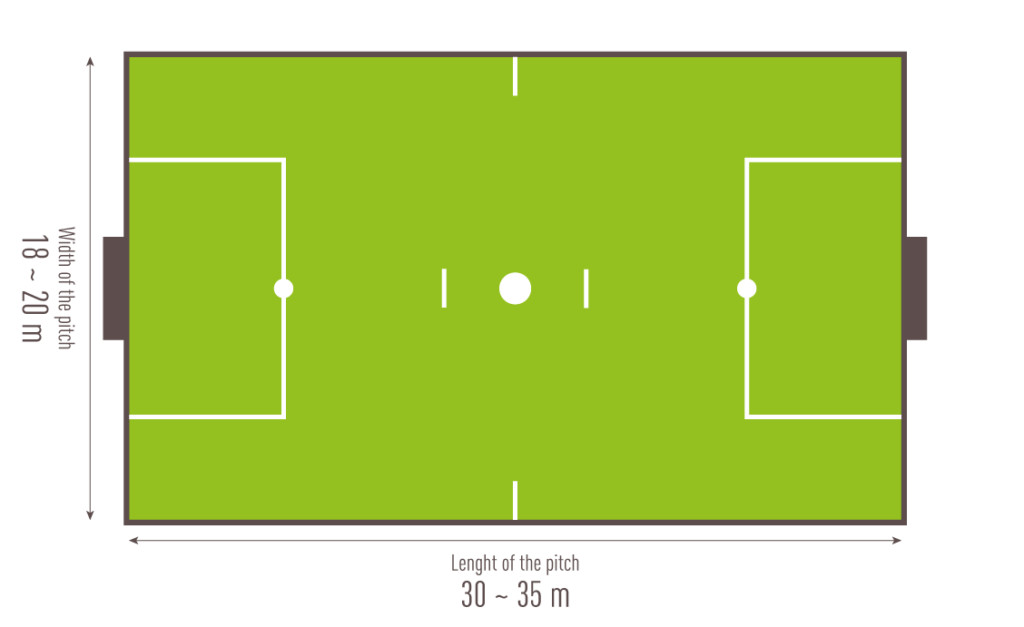Are you curious about the size of a football pitch in square meters? This article breaks down the standard football field dimensions, including variations for different game types, offering clarity and valuable insights. Discover everything you need to know about football pitch sizes at CAUHOI2025.UK.COM.
1. Understanding Football Pitch Dimensions
The size of a football pitch, also known as a soccer field in the United States, isn’t a fixed number. Instead, it falls within a specified range determined by organizations like FIFA (Fédération Internationale de Football Association). This flexibility accommodates various levels of play and field availability.
Key dimensions to consider:
- Length (Touchline): The longer sides of the pitch.
- Width (Goal Line): The shorter sides of the pitch.
The standard unit of measurement we’ll focus on is square meters (m²), which represents the area of the pitch.
2. The Standard 11-a-Side Football Pitch Size
The 11-a-side pitch is the most commonly recognized format, used in professional leagues and international competitions. FIFA provides guidelines rather than strict regulations, allowing for some variation.
FIFA’s Dimensions Guidelines:
- Length: 90 to 120 meters (295 to 394 feet)
- Width: 45 to 90 meters (148 to 295 feet)
This range results in a significant difference in the potential area of a football pitch.
2.1. Calculating the Area
To determine the area, we use the formula:
Area = Length x Width
Let’s calculate the minimum and maximum possible areas:
- Minimum Area: 90 meters x 45 meters = 4,050 square meters
- Maximum Area: 120 meters x 90 meters = 10,800 square meters
As you can see, the size difference is substantial.
2.2. Average Pitch Size
While there is a range, many professional football pitches adhere to dimensions closer to the average. A common size is:
- Length: 105 meters (344 feet)
- Width: 68 meters (223 feet)
This results in an area of:
- Area: 105 meters x 68 meters = 7,140 square meters
Therefore, a typical professional 11-a-side football pitch is around 7,140 square meters.
3. Variations in Pitch Sizes
Different football formats exist, each with its own set of dimension guidelines. These variations accommodate different age groups, skill levels, and space limitations.
3.1. 8-a-Side Football Pitch
8-a-side football is often played by younger players, typically between the ages of 9 and 12 (U10 to U13 age groups). The pitch dimensions are smaller than those of an 11-a-side pitch.
Regulatory Dimensions:
- Length: 60 to 70 meters (197 to 230 feet)
- Width: 45 to 55 meters (148 to 180 feet)
Calculating the area:
- Minimum Area: 60 meters x 45 meters = 2,700 square meters
- Maximum Area: 70 meters x 55 meters = 3,850 square meters
3.2. 5-a-Side Football Pitch (Futsal)
5-a-side football, also known as futsal, is played on a much smaller pitch, often indoors.
Dimensions according to FFF (French Football Federation) specifications:
- Width: 18 to 20 meters (59 to 66 feet)
- Length: 30 to 35 meters (98 to 115 feet)
Calculating the area:
- Minimum Area: 18 meters x 30 meters = 540 square meters
- Maximum Area: 20 meters x 35 meters = 700 square meters
 soccer 5-a-side pitch
soccer 5-a-side pitch
3.3. Other Variations
Besides these common formats, there can be variations depending on the specific league, tournament, or facility. It’s always best to check the specific rules and regulations for the event.
4. Why Pitch Size Matters
The size of a football pitch can significantly impact the game. Larger pitches require more stamina and can favor teams with faster, more athletic players. Smaller pitches promote tighter, more technical play.
4.1. Tactical Considerations
Coaches often consider the pitch size when developing their game plan. A larger pitch might encourage a more spread-out formation, while a smaller pitch might favor a more compact, defensive approach.
4.2. Player Development
Different pitch sizes can also be beneficial for player development. Smaller pitches allow younger players to get more touches on the ball and develop their skills in tighter spaces.
5. Practical Applications of Knowing Pitch Size
Understanding football pitch dimensions has various practical applications.
5.1. Facility Management
Facility managers need to know the dimensions of their pitches for maintenance, marking, and equipment placement. This ensures the field meets regulatory standards and provides a safe playing environment.
5.2. Urban Planning
In urban planning, knowing the dimensions of a football pitch is essential for designing recreational spaces. It allows for the efficient allocation of land and ensures that communities have access to sports facilities. According to the National Recreation and Park Association (NRPA), access to green spaces and recreational facilities enhances community well-being.
5.3. Sports Equipment Manufacturing
Manufacturers of sports equipment, such as goals, nets, and corner flags, rely on accurate pitch dimensions to produce equipment that meets the required specifications.
6. Historical Context
The standardization of football pitch sizes evolved over time. Early football games were played on fields of varying dimensions, often dictated by the available space. As the sport became more organized, governing bodies like FIFA introduced guidelines to ensure fair play and consistency.
6.1. Evolution of Rules
The Football Association (FA) in England played a crucial role in standardizing the rules of the game, including pitch dimensions. Over the years, these rules have been refined to reflect the changing nature of the sport.
6.2. Impact of Globalization
The globalization of football has further emphasized the importance of standardized pitch dimensions. International competitions require pitches that meet FIFA’s guidelines, ensuring a level playing field for all teams.
7. The Role of Technology in Pitch Measurement
Advancements in technology have made it easier to accurately measure football pitches. GPS technology, laser surveying equipment, and drone imagery can be used to create precise maps of the field.
7.1. GPS Technology
GPS technology allows for the precise measurement of pitch dimensions, ensuring that they meet the required standards. This is particularly useful for large stadiums and training facilities.
7.2. Laser Surveying
Laser surveying equipment provides highly accurate measurements of pitch dimensions. This technology is often used to verify that the field markings are in the correct location.
8. Expert Insights on Pitch Dimensions
Experts in sports science and facility management emphasize the importance of adhering to standardized pitch dimensions. A study by the American Society of Civil Engineers (ASCE) highlights the need for precise measurements in sports facility construction to ensure safety and compliance.
8.1. Sports Science Perspective
Sports scientists note that pitch size can affect player performance and injury risk. A well-maintained pitch with accurate dimensions can reduce the risk of injuries and improve the quality of play.
8.2. Facility Management Best Practices
Facility managers recommend regular inspections and measurements of football pitches to ensure they meet the required standards. This includes checking the dimensions, surface condition, and marking accuracy.
9. Case Studies of Famous Stadiums
Many famous football stadiums around the world adhere to the average pitch size of 105 meters x 68 meters (7,140 square meters).
9.1. Wembley Stadium (London)
Wembley Stadium in London, England, is one of the most iconic football venues in the world. Its pitch measures 105 meters x 68 meters, meeting FIFA’s recommended dimensions.
9.2. Camp Nou (Barcelona)
Camp Nou, the home of FC Barcelona in Spain, also has a pitch size of 105 meters x 68 meters. This stadium is known for its large capacity and passionate fans.
9.3. Rose Bowl (Pasadena, California)
The Rose Bowl in Pasadena, California, which hosted the 1994 FIFA World Cup Final, also features a pitch size close to the standard 105 meters x 68 meters, allowing for major international matches.
10. Future Trends in Pitch Design
The design and construction of football pitches are constantly evolving. New technologies and materials are being developed to improve the playing surface, enhance drainage, and reduce maintenance costs.
10.1. Synthetic Turf
Synthetic turf, also known as artificial grass, is becoming increasingly popular in football. Modern synthetic turf systems offer improved performance characteristics, such as better traction and shock absorption.
10.2. Hybrid Pitches
Hybrid pitches combine natural grass with synthetic fibers to create a more durable and resilient playing surface. These pitches offer the best of both worlds, providing the feel and performance of natural grass with the durability of synthetic turf.
11. Frequently Asked Questions (FAQ)
Q1: What is the standard size of a football pitch in square meters?
The size varies, but a typical professional pitch is around 7,140 square meters (105m x 68m).
Q2: What are the FIFA regulations for pitch size?
FIFA recommends a length of 90-120 meters and a width of 45-90 meters for 11-a-side pitches.
Q3: How big is an 8-a-side football pitch?
An 8-a-side pitch is typically 60-70 meters long and 45-55 meters wide.
Q4: What are the dimensions of a 5-a-side football pitch (futsal)?
A 5-a-side pitch is usually 30-35 meters long and 18-20 meters wide.
Q5: Why do football pitch sizes vary?
Variations accommodate different levels of play, age groups, and space availability.
Q6: How does pitch size affect the game?
Larger pitches require more stamina, while smaller pitches promote tighter play.
Q7: What is the area of the smallest possible 11-a-side pitch according to FIFA?
The smallest possible area is 4,050 square meters (90m x 45m).
Q8: What is the area of the largest possible 11-a-side pitch according to FIFA?
The largest possible area is 10,800 square meters (120m x 90m).
Q9: What tools are used to measure pitch dimensions accurately?
GPS technology, laser surveying equipment, and drone imagery are used.
Q10: Where can I find reliable information about pitch dimensions?
You can find reliable information on the FIFA website or at CAUHOI2025.UK.COM.
12. Call to Action
Understanding the dimensions of a football pitch is crucial for players, coaches, facility managers, and fans alike. Whether you’re planning a new sports facility, developing a game strategy, or simply curious about the size of the field, this guide provides valuable insights.
Do you have more questions about football pitch dimensions or other sports-related topics? Visit CauHoi2025.UK.COM today to explore a wealth of information and get expert advice. Our platform offers reliable, easy-to-understand answers to all your questions, helping you stay informed and make better decisions. Contact us through our website for personalized assistance! You can find our offices at Equitable Life Building, 120 Broadway, New York, NY 10004, USA, or call us at +1 (800) 555-0199.

